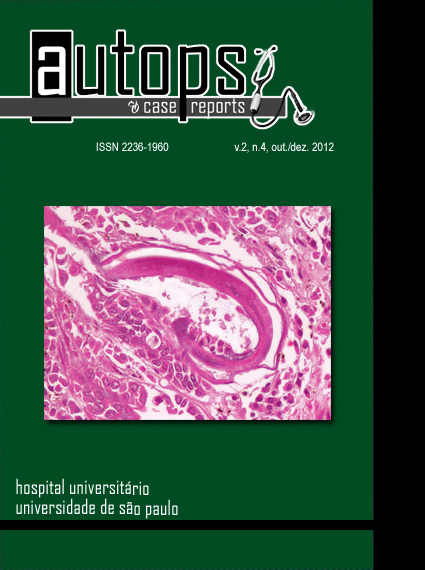Strongyloides stercoralis disseminated infection and schistosomiasis in an AIDS patient
Keywords:
Acquired immunodeficiency syndrome, Strongyloides stercoralis, Schistosoma mansoni, Respiratory insufficiency, Autopsy.Abstract
Strongyloides stercoralis hyperinfection syndrome is classically associated with impaired host response and implies in an overburden of larvae in its usual cycle. It has been recognized as a severe and potentially fatal condition in immunocompromised individuals, especially those using oral corticosteroids. Infection with Schistosoma mansoni not only increases the susceptibility to HIV infection, but also promotes progression to disease. The association of the most severe forms of strongyloidiasis and AIDS is scarcely described, even more when S. mansoni is also associated. The authors describe a case of a 34-year-old previously healthy male, admitted to the emergency department with a history of hematemesis associated with dyspnea, hemoptysis, and fever. He referred homosexual relations for 6 years. Physical examination showed an ill-looking patient, and was remarkable for tachycardia, tachypnea, diaphoresis, and pulse oximetry of 70% in room air. Lungs examination revealed the presence of rales in the left base. Chest radiography showed a diffuse and bilateral reticulo-nodular pattern. HIV serology was positive. Empirical antimicrobial therapy and corticosteroids were initiated. On the third day of hospitalization, petechiae appeared over the periumbilical area, but no further investigation was undertaken because the patient died soon after. The autopsy findings were compatible with S. stercoralis disseminated infection, a hepatic intestinal chronic form of schistosomiasis, and septic shock as the primary cause of death. The authors call attention to this infrequent association.Downloads
Download data is not yet available.
Downloads
Issue
Section
Article / Autopsy Case Report
License
Copyright
Authors of articles published by Autopsy and Case Report retain the copyright of their work without restrictions, licensing it under the Creative Commons Attribution License - CC-BY, which allows articles to be re-used and re-distributed without restriction, as long as the original work is correctly cited.
How to Cite
Brandão, R. M., Brandão, R. P. M., Gonçalves, A. C. M. A., Laborda, L. S., Lima, P. P. de, & Campos, F. P. F. de. (2012). Strongyloides stercoralis disseminated infection and schistosomiasis in an AIDS patient. Autopsy and Case Reports, 2(4). https://www.revistas.usp.br/autopsy/article/view/48323



